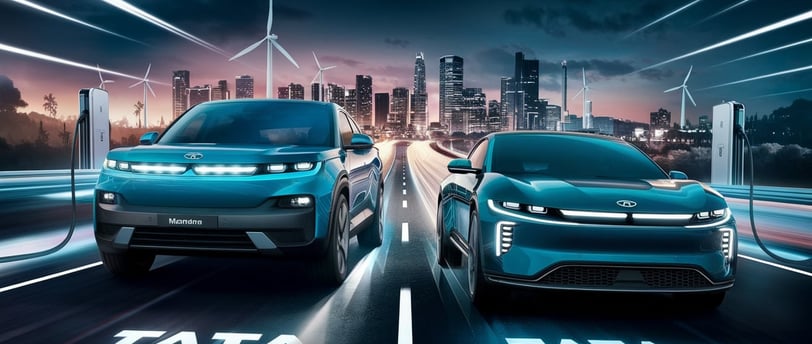Mahindra Closes in on Tata Motors: The EV Battle Heats Up as Sales Falter
Blog post description.Mahindra vs Tata Motors: The EV race is heating up! 🚗⚡ Mahindra’s XUV400 is closing in on Tata’s Nexon EV as sales dynamics shift in the Indian electric vehicle market. Who will dominate the future of sustainable mobility? 🌍⚙️ Watch now to find out!
BLOG POST
EV Nova Tech
12/16/20244 min read


Mahindra Closes in on Tata Motors: The EV Battle Heats Up as Sales Falter
India's electric vehicle (EV) market is buzzing with potential, promising a sustainable future fueled by innovation. At the forefront of this transition, two automotive giants, Tata Motors and Mahindra & Mahindra, are engaged in an intense rivalry to dominate the EV space. However, with faltering sales and shifting dynamics, the balance of power is tilting. Let’s dive into the details of how Mahindra is closing in on Tata Motors and what this means for the EV market in India.
The Current Landscape of the Indian EV Market
India’s EV adoption has accelerated over the past few years, driven by government incentives, environmental concerns, and a growing interest in reducing dependence on fossil fuels. Among the frontrunners, Tata Motors has long held a commanding lead, thanks to its aggressive pricing, early entry, and a strong portfolio that includes the Nexon EV, Tigor EV, and the recently launched Tiago EV.
Mahindra, on the other hand, has been a seasoned player in the automotive sector but was initially slower to embrace EVs compared to Tata. However, the company has made significant strides in recent years, thanks to its visionary approach and strategic partnerships.
Faltering Sales: A Growing Concern for Tata Motors
Despite its dominance, Tata Motors has recently faced challenges in maintaining its sales momentum in the EV segment. Several factors have contributed to this dip:
Rising Competition: New entrants like Mahindra and foreign automakers such as Hyundai and BYD are creating a more competitive environment.
Consumer Expectations: Early adopters are now seeking advanced features and better range, areas where Tata's current models are beginning to lag.
Supply Chain Issues: Global semiconductor shortages and fluctuating raw material prices have impacted production schedules, leading to longer delivery timelines.
Stiff Pricing: While Tata’s pricing strategy was initially a game-changer, rising costs and competition have diluted its edge.
Mahindra’s Resurgence: The Electric XUV Revolution
Mahindra is leveraging this opportunity to aggressively expand its EV footprint. The recent launch of its XUV400 EV has garnered significant attention, presenting itself as a direct rival to Tata's Nexon EV. Here’s why Mahindra’s EV strategy is making waves:
Strategic Focus on SUVs: Mahindra’s strength has always been in the SUV segment, and it’s doubling down on this expertise with electric SUVs like the XUV400.
Partnerships and Innovation: Collaborations with global players like Volkswagen for EV components have enabled Mahindra to enhance its technology and scale up production.
Range and Features: The XUV400 boasts a competitive range of up to 456 km on a single charge, along with advanced infotainment systems and safety features, appealing to tech-savvy buyers.
Production Expansion: Mahindra has committed significant investments in building EV-specific manufacturing facilities, signaling its long-term commitment to this space.
The Consumer Perspective: What’s Driving the Shift?
Indian consumers have become increasingly discerning, valuing features like range, charging infrastructure, and affordability. While Tata Motors initially captured this audience, Mahindra’s focus on premium design and performance is resonating with a new segment of buyers who prioritize style and innovation over cost alone.
Take the example of Ramesh Sharma, a 35-year-old IT professional from Bengaluru. He recently switched to the XUV400 after considering the Nexon EV, citing better range and a sleeker design as his reasons. Stories like Ramesh’s highlight the shifting consumer preferences that are reshaping the market.
The Role of Government Policies and Incentives
The Indian government’s push for electrification under the Faster Adoption and Manufacturing of Hybrid and Electric Vehicles (FAME) scheme has been instrumental in driving EV adoption. However, as these subsidies gradually taper off, automakers are finding themselves under pressure to innovate while keeping costs low.
Mahindra appears better positioned to navigate this transition, thanks to its strategic investments in technology and global collaborations. Tata Motors, while still a dominant player, will need to double down on R&D to maintain its edge.
Challenges Ahead for Both Giants
Despite their progress, both Tata Motors and Mahindra face hurdles in scaling their EV operations. Key challenges include:
Charging Infrastructure: India’s EV growth is heavily dependent on the availability of a robust charging network, which remains inadequate in many regions.
Battery Supply and Costs: The reliance on imports for lithium-ion batteries makes manufacturers vulnerable to global price fluctuations.
Consumer Awareness: While urban centers are witnessing increased adoption, rural areas still exhibit skepticism due to a lack of awareness and infrastructure.
Mahindra vs. Tata: Who Will Win the EV Race?
As Mahindra closes in on Tata Motors, the Indian EV market is poised for an exciting showdown. While Tata has the advantage of being a first mover and a larger portfolio, Mahindra’s innovative approach and focus on premium SUVs give it a strong competitive edge.
This rivalry is not just about numbers; it’s about shaping the future of sustainable mobility in India. Both companies are investing heavily in research, infrastructure, and marketing, ensuring that consumers have more choices and better access to EV technology.
Looking Ahead: What’s Next for the Indian EV Market?
The Indian EV market is expected to grow exponentially, with estimates suggesting that EVs will account for 30% of new vehicle sales by 2030. This opens up immense opportunities for automakers to innovate and capture market share.
Affordable EV Models: Manufacturers are likely to introduce more budget-friendly models to cater to middle-class consumers.
Technological Advancements: From solid-state batteries to autonomous driving features, the next wave of innovation will redefine what consumers expect from EVs.
Local Manufacturing: To reduce costs and reliance on imports, companies will ramp up local production of components, including batteries and motors.
FAQs
1. Why are Tata Motors’ EV sales faltering?
Tata Motors is facing challenges due to rising competition, supply chain disruptions, and evolving consumer preferences that demand more advanced features and better range.
2. What makes Mahindra’s EV strategy stand out?
Mahindra’s focus on electric SUVs, strategic partnerships with global players, and its investment in advanced technology and manufacturing are key factors driving its growth in the EV segment.
3. How is the Indian government supporting EV adoption?
The government provides subsidies under the FAME scheme and offers tax benefits for EV buyers. However, as these incentives reduce over time, the focus is shifting toward infrastructure development and long-term sustainability.
4. What are the main challenges facing EV manufacturers in India?
Key challenges include inadequate charging infrastructure, reliance on imported batteries, and limited awareness in rural areas about EV benefits and usage.
5. Which company is better positioned for the future: Tata Motors or Mahindra?
Both companies have their strengths—Tata’s first-mover advantage and Mahindra’s innovation-driven approach. The winner will likely be the one that can balance affordability, technological advancements, and consumer satisfaction effectively.
